Home >
Mashonaland West >
Thomas Baines journey to Mashonaland in 1870 after Lobengula granted a verbal mineral concession and the first mining claim at Hartley Hills - Part 2
Thomas Baines journey to Mashonaland in 1870 after Lobengula granted a verbal mineral concession and the first mining claim at Hartley Hills - Part 2
Introduction
Part 2 covers the journey Baines made to the northern goldfields for the second time in 1870, continuing from Part 1 when he made his first 1869 journey; details are from The Northern Goldfields Diaries of Thomas Baines edited by John P.R. Wallis.
The reason we know so much about Baines’ journeys to the northern goldfields is that he was meticulous in keeping his diaries up to date, in fact making three or four carbon copies that were sent to Edwin Oliver, the London secretary of the South African Gold Fields Exploration Company, his mother Mary Ann Baines (née Watson) and possibly the Royal Geographical Society.
In 1870, as in 1869, his South African Gold Fields Exploration Company assistants were Robert Jewell and William Watson. Nelson, the company mineralogist in 1869, left with Hübner in January 1870 supposedly to request better support from the London directors for the exploration efforts, but it was clear there were no funds and he was hired by Sir John Swinburne to work for the London and Limpopo Mining Company at Tati.
Both Jewell and Watson were somewhat immature and failed to appreciate the energy Baines spent on mapping, his natural history interests and the time he spent on drawing and painting[i] but Baines was not a person who bore grudges and their relationship was always good due to his unfailing sense of humour.
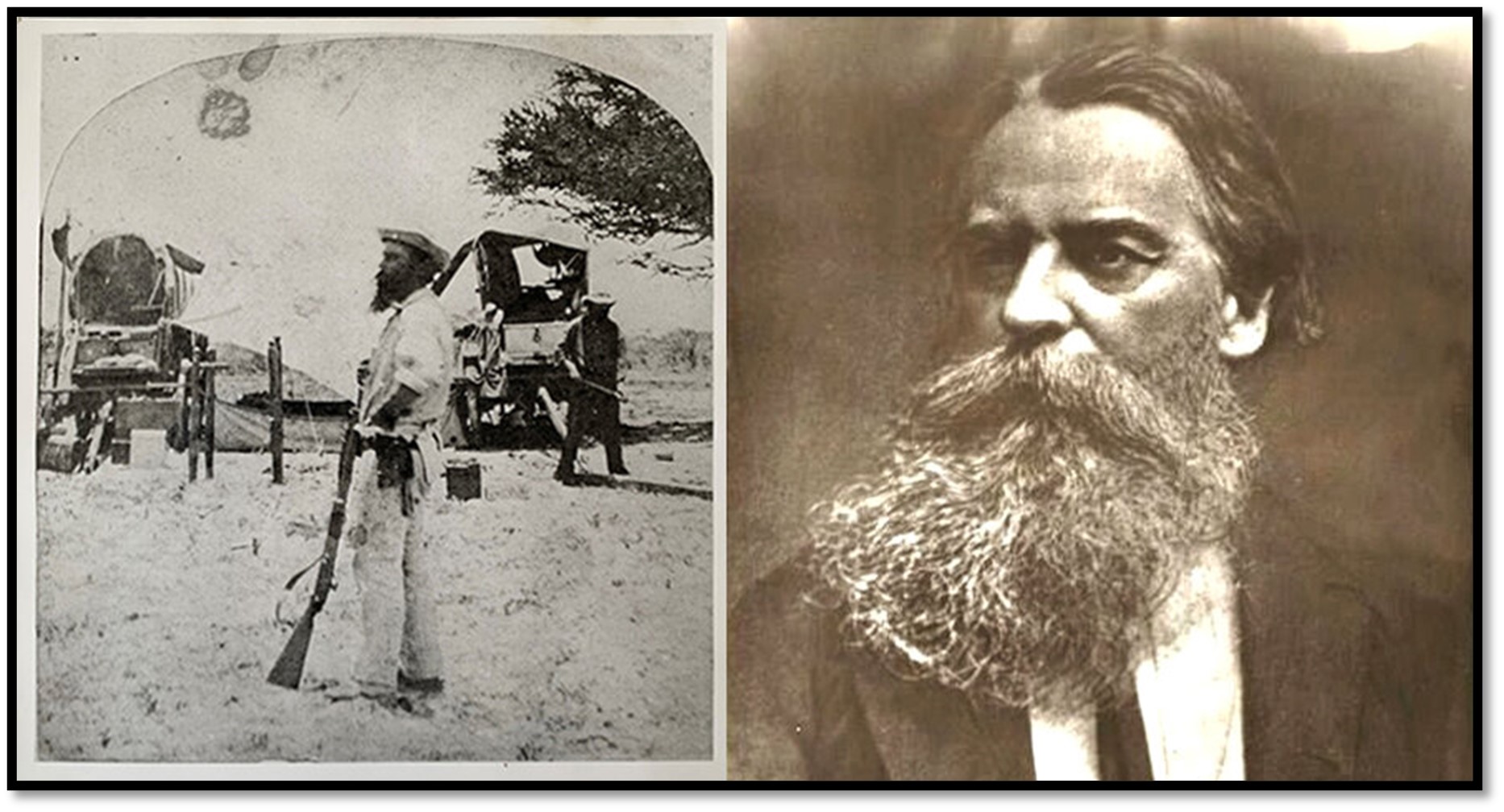
National Library of Australia: The noonday photo of Baines on the left – ‘Man with no shadow’ was taken by James Chapman on their journey from Walvis Bay to the Victoria Falls and Logier Hill. Both men published accounts: Thomas Baines in Explorations in South West Africa published in 1864 and James Chapman in Travels in the Interior of South Africa published in 1868.
A summary of the events in year 1870 leading to the first mining claim
1869 – the year ended with all the Europeans except missionaries ordered out of the country so that the amaNdebele could decide their ruler’s succession without outside interference and Baines divided his time between Mangwe and Tati.
1870 – Baines was at Mangwe when Lobengula’s coronation took place on 24 January. On 18 March Lobengula said to John Lee “Yes, Mr Baines can have the northern goldfields.” The king confirmed to Baines personally on 9 April that he had permission to dig for gold, build a house at Hartley Hills and bring crushing plant into the country and that he trusted Baines to adhere strictly to the terms of his permission. Baines trekked to Mashonaland with Robert Jewell and William Watson; Nelson had not returned. They reached Hartley Hills on 25 June; Baines, Jewell and Inyassi, their amaNdebele guide, then walked the claim area of the South African Gold Fields Exploration Company and started the construction of a house. In early July George and Swithin Wood’s party arrived having suffered many deaths from fever. Baines trekked to Umtigesa’s village to buy grain, goats and pack-oxen and in August rode down the Mupfure river examining the Mashona gold workings. He met Henry Hartley who has been hunting at the Manyame river and joined the group for an elephant hunt on the Chirundazi stream. On 29 August they visited the grave of Willie Hartley. Baines joined Wood and Hartley on a hunting trip to the Imbeela river – extensive gold diggings were seen and quartz samples collected. On 26 September they left Hartley Hills on the Hunters Road with the Wood and Hartley parties hunting elephant as they travelled. Baines was guided to the goldfields northwest of the Bembezaan river that had been previously shown to Karl Mauch (probably the future Gaika Mine) On 28 October they reached Inyati mission before trekking on to see the king where Revd Thomson asked for permission to build a mission at Hope Fountain. The king was anxious because Levert of the London and Limpopo Mining Company had a concession from Lobengula and had thrown open the Tati district to individual miners giving himself the right to make a claim for every one they chose for themselves. As Lobengula put it to Baines: “I gave Mr Levitt a cow to milk and he might have milked her dry. But now he wants not only the milk but claims the cow as if he had won her by conquest.” On 26 November Baines left the king’s capital for Tati and on 8 December he left for Natal.
Baines second journey in 1870 with quotes from ‘The Northern Goldfields Diaries of Thomas Baines’
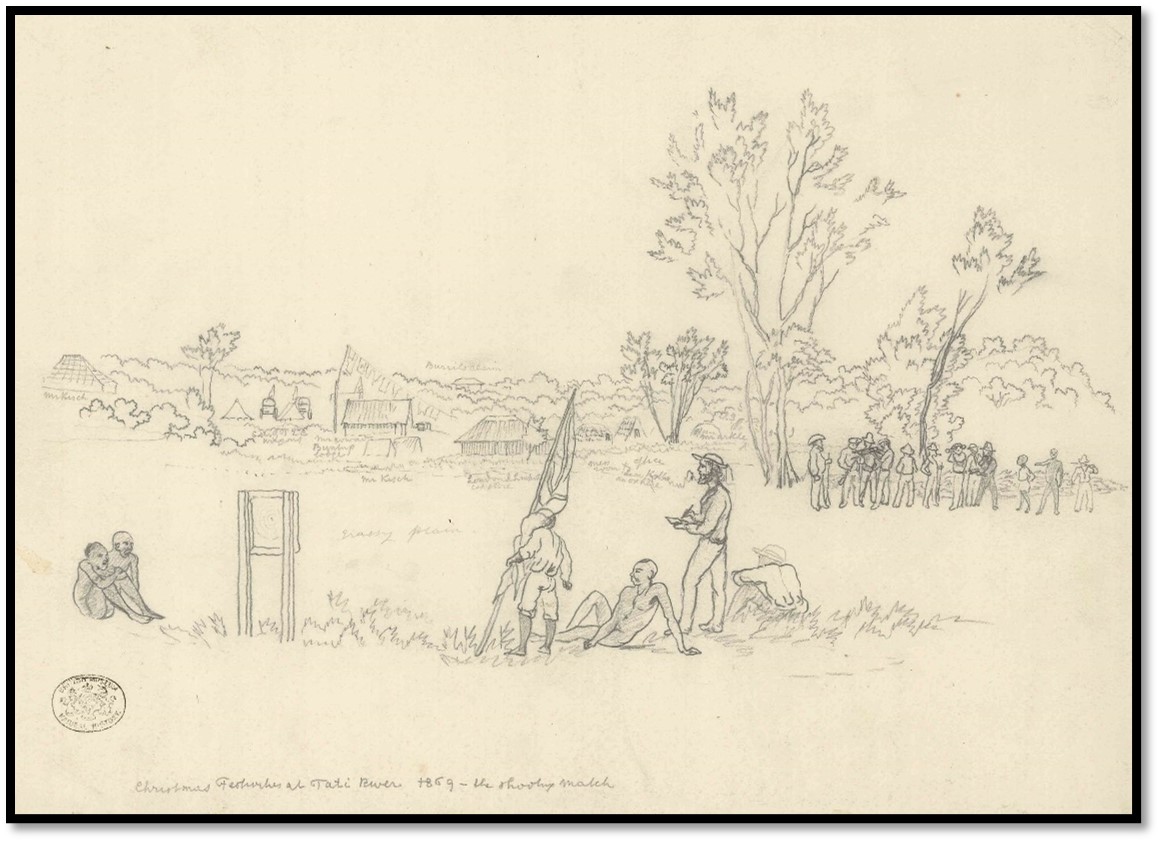
NHM (London) Baines Collection No 34: Christmas festivities at Tati River 1869 – the shooting match
Baines and the expedition members are at Tati
Nelson, his wagon painted royal blue, left Tati on 7 January with Hübner; the same day Baines was taken around the Tati diggings by Valentine. They visited ‘Captain’ Burrill’s claim,[ii] an old working that had been dug to 50 feet with gunpowder and then the claim of the Glasgow and London Company whose shaft was at a similar depth and followed a small, but rich vein of quartz. Another shaft connected by inclines apparently went down 90 feet but was not explored.
Many of the expedition attendants from 1869 – Kameela, Palhallah and John Fontein requested their discharge at Tati as Baines prepared to return to Mangwe. He left the wagon at the Impakwe river and walked on reaching Mangwe on 9 January. Watson was there with Henry Byles and King; Sam Edwards was also outspanned and John Lee was at his home.
Baines and John Lee decide they must disclose Erskine’s letter to the amaNdebele councillors
Baines showed Lee a letter just received from Major David Erskine[iii] that stated Kuruman was in Natal and suggested sending a wagon down to Natal with Lobengula or the councillors so they might see the Natal governor and bring Kuruman back. They decide they must go to Inthlathlangela and read the letter to the councillors to pre-empt Levert and the London and Limpopo Mining Company.
When Baines checked the stores he had left at Lee’s, he found everything correct except for his cognac supplies. Baines tells the men he must “inflict a heavy punishment, which would be to drink the Queen’s health in another bottle and they confessed they had deserved their fate and were prepared to submit to it like men. One however intimated that Mr Lee was the principal offender and I proposed on that account to punish him alone and forgive the rest, but the culprits did not appreciate my merciful intentions and declared themselves prepared to meet their doom.”
Next day they were at Manyame’s kraal who let them pass and by the following day had crossed the Shashani river and reached the ‘top of the hill’ and were following the watershed when they met George Phillips who told them the amaNdebele were increasingly disinclined to believe that Kuruman was alive and living in Natal.
Lee and Baines meet Lobengula and the councillors but do not disclose the contents of the letter
Having crossed the Kumalo river and reached Inthlathlangela they met several of the principal councillors including Lotje, Umlomo, Mghoba and Umtigan who all told Lee that the majority of amaNdebele wanted Lobengula as their ruler, but a few opposed him, including Umbeko of the Zwangendaba regiment, the Ingubo, the Induba and Nyamandhlovu regiments. They advised Lee to remain silent about Erskine’s letter as it would just cause further tensions.
Next day they were greeted by Lobengula at his kraal and he had breakfast with them. Baines left Lee in conversation with Lobengula (already he is writing ‘the king’ in his diary) and joined Willie Hartley, Hudson,[iv] Harry Grant and William Thomas who had all received permission to come this far, but no further. The friendship with Lobengula was renewed and Baines was told to return to discuss business when Lobengula had been appointed king and by the 15th of January Baines was back at Mangwe.
On the 14th Sir John Swinburne, leader of the London and Limpopo Mining Company, was temporarily blinded for three days by the venom of a spitting cobra with Dr Coverley at Tati caring for him. Swinburne then left ten days later for London, universally disliked by everyone for his disagreeableness, leaving Arthur Levert in charge of operations at Tati.
Lobengula’s succeeds as king of the amaNdebele on 24 January 1870
A few days later three amaNdebele came from Umbeko to ask Lee what news there was of Kuruman being in Natal – no mention was made of Erskine’s letter and on the 21st Lee was summoned to Inthlathlangela by Ncumbata, the amaNdebele regent. He returned to Mangwe on the 27th and told those assembled for breakfast at Baines tent that Lobengula had been declared king on the 24th and the successor of his father Mzilikazi with over 9,000 warriors present at the coronation. Those present to hear this news include H. Grant, W. Hartley, R. Hudson, J. Lee, J. O’Donnell, G.A. Phillips, Revd W Sykes, Revd T.M. Thomas, W. Thomas and G. Westbeech.
A new capital is to be built at Gibxhegu and then renamed koBulawayo and Lobengula has stopped wearing European clothes after his coronation, probably to show his approval of amaNdebele culture. Not all amaNdebele welcomed Lobengula, Umbeko was absent from the coronation and sent small parties of the Zwangendaba regiment to fetch up Kuruman.
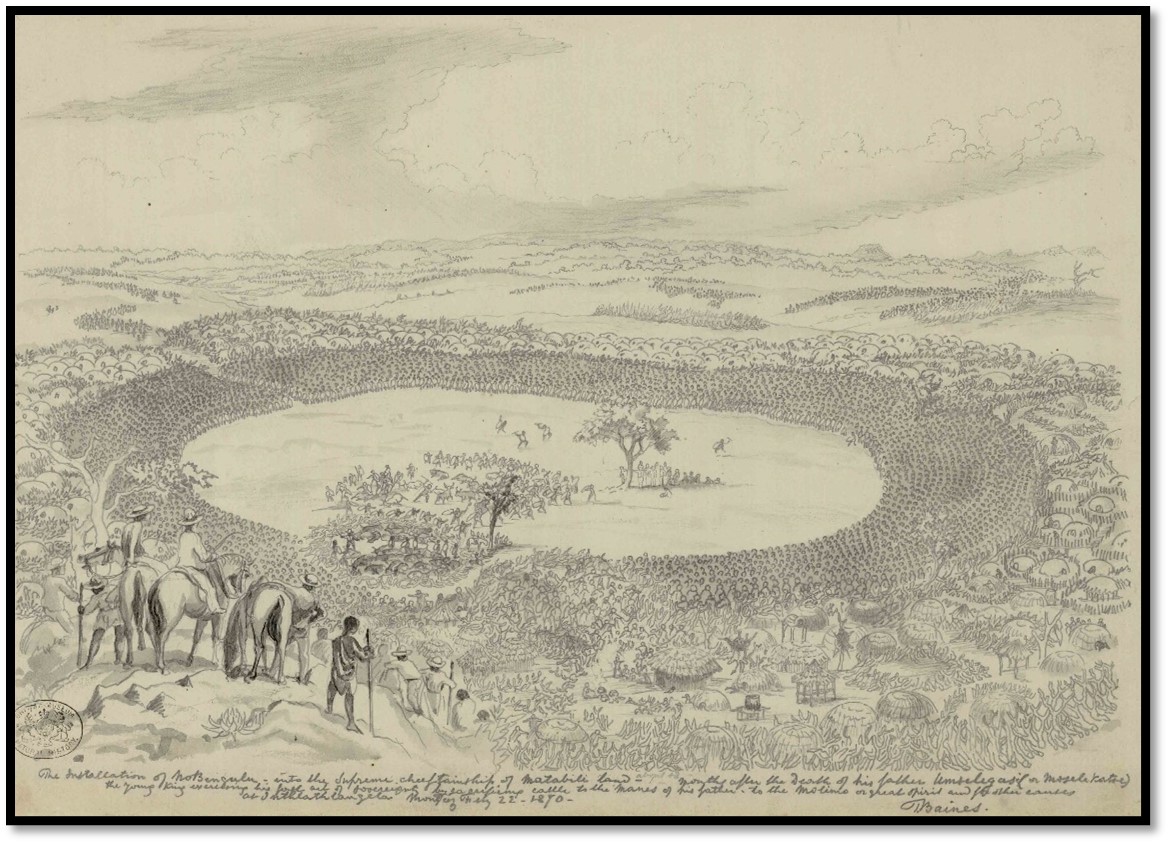
NHM (London) Baines Collection No 36: the installation ceremony of Lobengula as king of the amaNdebele with cattle being sacrificed to the ancestors on 22 January 1870
Baines signs up John Lee as the company agent
Lee told Jewell and Watson that he hoped the South African Gold Fields Exploration Company would make an agreement with him for his services. Baines has already proposed to the company directors a £200 annual payment to Lee as the company’s agent on condition they get a mining concession. They have seen gold at Hartley Hills and Nelson was confident it would be payable.[v]
On 1 February Watson had fitted up the bellows at his forge and was hard at work with his hammers beating out a piece on the riem shoe that did duty as an anvil, but the noise was too great for mapping and so Baines went over to Lee’s to show him the places on the map that looked gold bearing. These were between the Bembezaan, Sebakwe and Umniati (Munyati) rivers, the Chimbo rivulet that joins the Umfuli (Mupfure) at Hartley Hills, the quartz hills near the Imbeela and Inzinghazi rivers and the old Mashona workings northwest of their camp on the Ganyana (Hunyani / Manyame) river. They discussed how much country to request from Lobengula. Lee suggested asking for the country between the Bembezaan and the Mupfure, Baines thought two smaller areas from the Bembezaan to the Munyati and the Mupfure to the Inzinghazi. This led onto the question of how much tribute Lobengula might ask from the company for the privilege.
On the same day an agreement was drawn up for Lee to act as the company’s agent in return for £200 per annum; signed on the company’s behalf by Baines and witnessed by Jewell.
On 3 February Baines started construction of a sawpit that they lined with planks, a few days later he went around Lee’s farm “and learned the family history of all his cattle.”
Sam Edwards and Warson began sawing the first log: “but as the sawing went like the course of true love, anything but smooth, we took spell and spell with them and by noon had begun to get a little accustomed to each other’s stroke.”
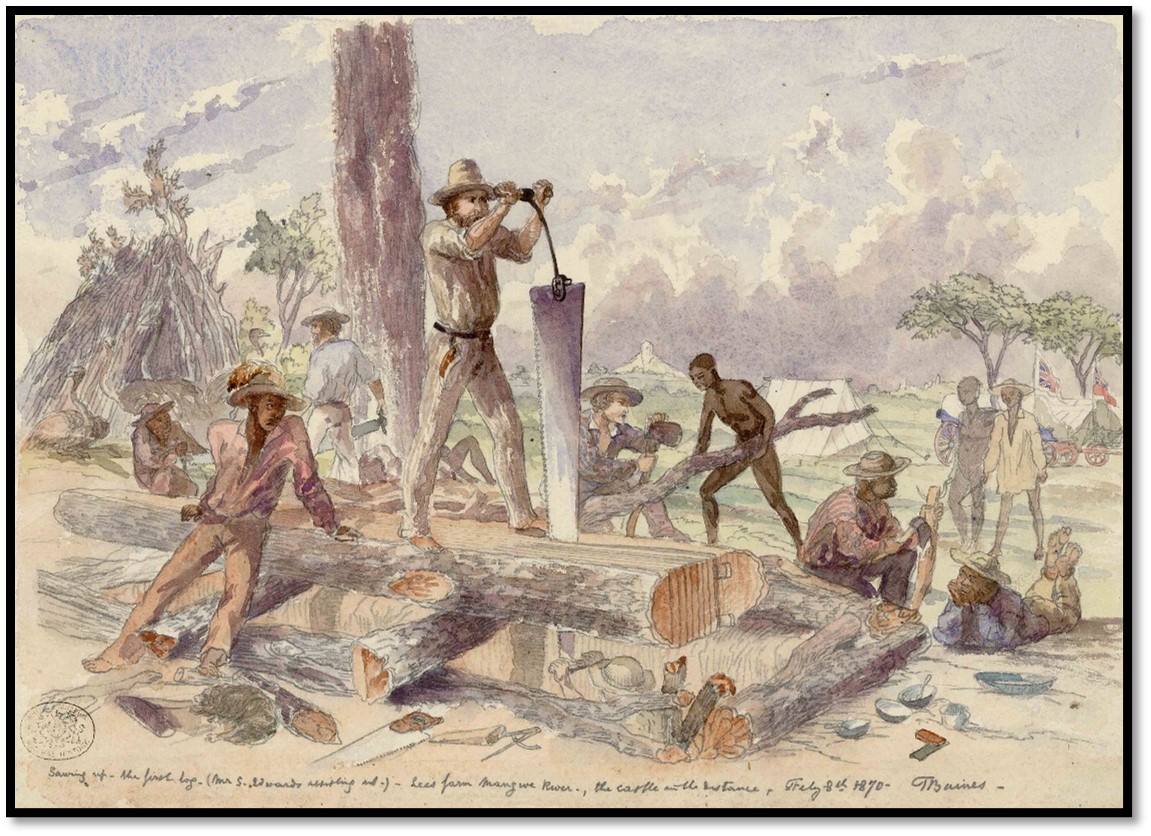
NHM (London) Baines Collection No 35: Sam Edwards and Baines sawing the first plank at the Mangwe Sawpit, various attendants around, Lee’s Castle in the background, their wagons on the right
Baines stays at Mangwe for February and March
Baines completed four copies of his map on the 13 February from Zwangendaba and Inyati mission to the Ganyana (Hunyani / Manyame) river and mounted one copy on calico. He observed that if they can navigate 200 miles of the Sabi (Save) river from the Indian Ocean coast by boat there would only be another 200 miles to the Umfuli (Mupfure) and Hartley Hills. Using this route to bring crushing plant up from Natal by steamship would be much cheaper than by wagon.
On Lee’s return from seeing the king on 18 March he told Baines that he had explained to Lobengula that he (Baines) had visited the northern goldfields the year before and complied with all of Ncumbata’s instructions and was now waiting at Mangwe for an answer. The king said he was satisfied and then added: “Yes, Mr Baines can have the northern gold fields.” He said he would discuss the tribute amount with Baines on his next visit to Gibxhegu.
Hunters visit Lobengula at Gibxhegu for permission to hunt in the next winter season
They included H. Byles, J. Gifford, J. Jennings, T. Leask, T. Maloney, H. McGillewie and G. Wood. Some commissioned paintings from Baines of hunt scenes for which he charged £10 - £12 each and used to buy food, trade goods and supplies for their next expedition to the northern goldfields.
The hunters all gave Lobengula presents in return for permission to hunt elephants. George Wood’s present of a salted horse cost £100. Baines was not hunting, but he wanted to continue his exploration for gold and Lee told him a salted horse[vi] would be appropriate and he could supply it for 336 lbs of beads!
Baines, Watson and driver Charlie accompanied by Du Plessis and Lee left Mangwe on 5 April and were not held up by Manyame and found Lobengula at Gibxhegu with his wagon and huts surrounded by a substantial stockade but the rest of the new town unfinished.
Lobengula grants a verbal mineral concession to Baines for the Northern Goldfields
On 9 April: “The ladies of the Royal family, Queens, Princesses Royal, etc for we were not yet quite able to appropriate to each her proper title – paid us a visit and were facetiously chatting with Mr Lee when a messenger arrived to call us to the king” After the usual small talk the king gave Baines permission to mine gold between the Gwelo (Gweru) and Hunyani (Manyame) rivers and to sink shafts, build storehouses and residences and to haul up crushing plant without paying tolls. But Lobengula would not sell the land and he warned Baines not to exceed the terms given.
Baines and Lee thought an appropriate present for Lobengula would be a salted horse, saddle, bridle and a good rifle but at the time Baines had no spare funds for any of these items, except the salted horse he had just acquired from Lee for £65 worth of beads, and he gave it to Lobengula. He wrote to the London directors suggesting a gift of two Whitworth or Armstrong mountain guns and ammunition for the king.
The South African Gold Fields Exploration Company party leave Gibxhegu for Inyati mission
After writing a proclamation concerning travel and hunting in southern Matabeleland and a letter confirming Lee as Lobengula’s agent, Baines travelled with the king to the new town near Gibxhegu. “His black oxen, as he humorously called his soldiers, hauled the wagon to the shade of a suitable tree and soon made a stout fence, 10 feet high and 3 or 4 feet thick, all round it.” Then Baines said farewell and travelled north to reach Inyati mission on 29 April. Items left in storage at Inyati were loaded into the wagons.
The London and Limpopo Mining Company are granted a written mining concession for the Tati goldfield
Revd Thomas said the king had granted Levert,[vii] who succeeded Swinburne in command of the company, the first written mining concession for the Tati goldfield on 29 April with Lobengula, Elton and principal councillors signing the document. The mining area covered was between the Shashe and Ramaquaban rivers from their source to their junction and included operating plant, erecting buildings and making roads for an annual tribute of £60 per annum. It was agreed the Makalanga people in the area were not to be molested by the amaNdebele as they supplied food and labour.
However the concession caused problems as its legal language was not explained to the amaNdebele. Lobengula believed the company had only the right to mine for gold, much as hunters were given permission to hunt elephant, but Levert allowed newcomers into the Tati area with licences granted by the London and Limpopo Mining Company and to stake claims in return for a ¼ share and the right to a company claim adjacent to each newcomers claim. The king would not recognise that Levert had the power to grant claims to newcomers.
Lobengula grants the mining concessions to consolidate his power
Eric Tabler believes that Lobengula understood that any influx of Europeans into his kingdom would complicate events but granted the concessions because he believed that if there was any future threat from Kuruman the two large English companies would support his claim to the throne to protect their own interests.
The first mining accident at Tati
On their return to Tati Levert and Elton visited the Halfway Reef. In the miners hut, James, one of the miners, accidently allowed embers from his pipe to fall into a barrel of blasting powder which blew up. James was killed, Levert badly burned and Elton, Rockey, Dalton and their native interpreter also hurt, Dr Coverley at Tati tended them. James was buried at Tati cemetery alongside Harley of the Glasgow Company who died of fever on 7 April.
The South African Gold Fields Exploration Company party leave for the Northern Goldfields
On 9 May Baines and his party left Inyati, there was heavy rain and the wagons often needed double spans of oxen to get free of the mud although Baines had chosen a route away from the Hunter’s Road and nearer the watershed as it was easier to cross the spruits. “The waggon was meanwhile lifted out by a complication of levers, till the double span of oxen were able to haul it out. We made a short trek, dragging each waggon alternately a few hundred yards, often nave deep through the saturated soil and never letting one follow on the ground that had been broken by the other…” At Umbangin village they were joined by their guide Inyassi, his son Macuthlumba and a young man named Golube (pig) The Vungu and Ngamo rivers were crossed on the 21st, the Gwelo (Gweru) on the 24th. They built a scherm at the Que Que (Kwekwe) believing Nelson was on his way. “A little more than a mile down the river, or north-north-east we found a fine reef of white quartz and an old Mashona digging which our men thought had been a game pit, being ignorant of gold working.” On 1 June they moved to the Bembezaan and two days later to the Sebakwe where two buffalo were shot before moving off on the 13 June and reaching the Umniati (Munyati) the following night.
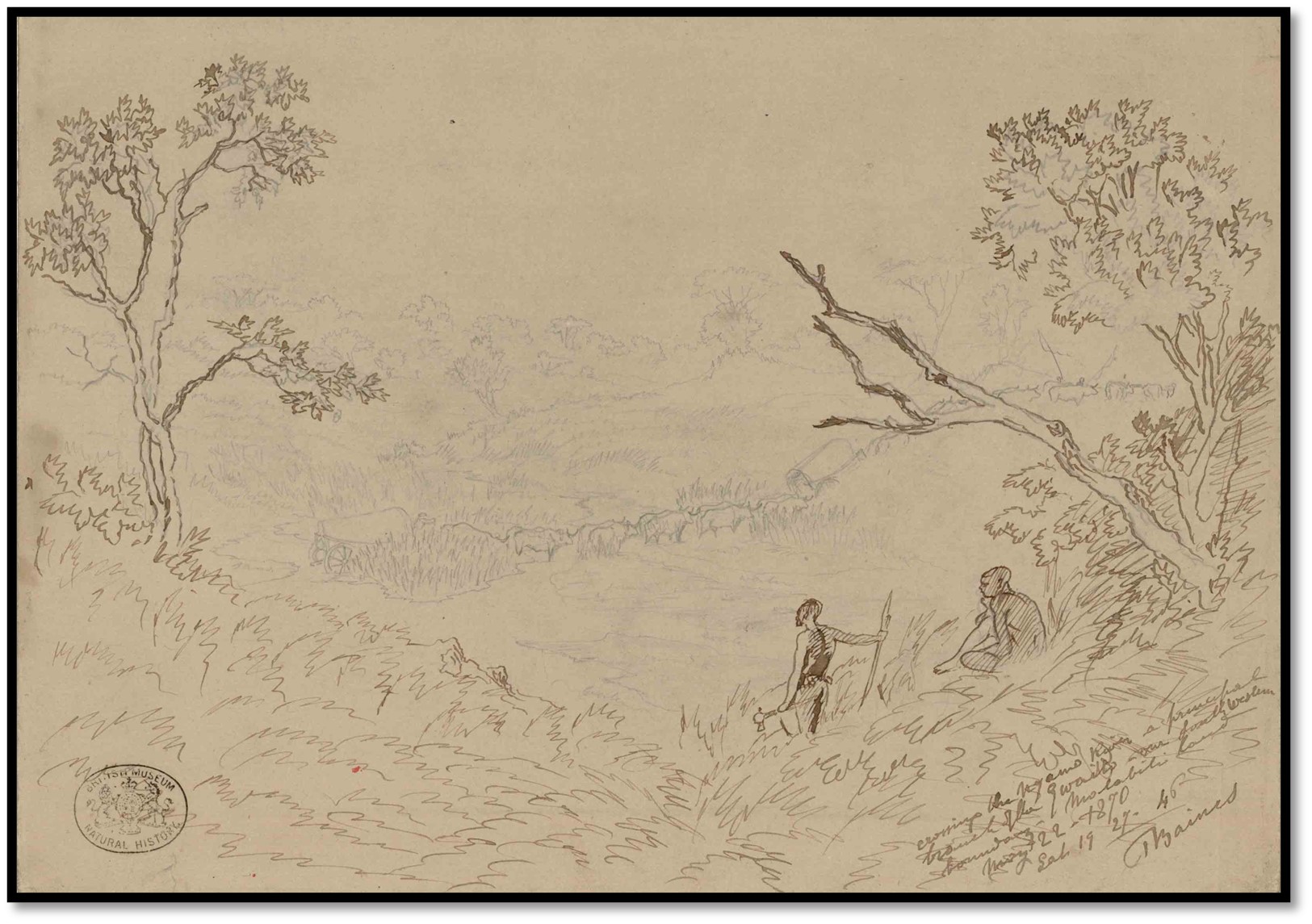
NHM (London) Baines Collection No 37: crossing the Ngamo river on 22 May 1870
Next day they crossed the Umgesi (Ngezi) but at a tiny rivulet beyond the Umgesana (Little Ngezi) a wagon wheel was smashed that took the combined efforts of Baines, Jewell and Watson five days to repair. The Umsweswe was reached on 22 June and soon they were at Mud Spruit and travelling north to the west of the Zintundusi (Chirundazi) to the Umfuli (Mupfure) drift: “which I was just wading when Jewell brought the waggons up, and our oxen being now in good condition, dragged them with only moderate difficulty over the broad and heavy sands which form in the intervals not kept clear by the passage of the river through the rocky permanent channel” before outspanning at Hartley Hills.
Lobengula puts down opposition to his rule
Lobengula tried his utmost to avoid confrontation but his councillors insisted that he put down the opposition mainly from Mbigo (Umbeko) and the Zwangendaba regiment but supported also by those of Bulana, Induba and Ingubo, about 1,500 Majaka in all. In mid-May he took his army to Zwangendaba and offered forgiveness if they acknowledged him as king, but they refused. He sent a messenger to invite them to talk over the matter, but the messenger was beaten and driven back. He sent another and Umbeko answered: “We can talk now only with assegais.”[viii]
Only on the third assault was the Zwangendaba stockade breached, over three hundred warriors were killed on both sides, women and children were spared, as were those that surrendered. The kraal was burnt down and those that refused to acknowledge Lobengula escaped to Bechuanaland and became bodyguards for Macheng.
The Baines party begin to construct a permanent camp at Hartley Hills
Baines, Jewell and Inyassi walk the claim of the South African Gold Fields Exploration Company. Starting at the Off-saddle tree [1] and going south along the line of old Mashona workings: “out native boys breaking up stones and looking in them for maali.” Having reached the Mopane and Mpondo trees [2] they walk southeast to an ant-hill where Baines had found a beautiful orchid the previous year. Then Baines asked Inyassi for the Impassa tree, but he had forgotten and Baines used his diary and took bearings and found the tree much to the astonishment of the natives. Then turning back they traced the boundary to the northwest angle of the Simbo [Chimbo] rivulet [3] renewing the marks and then turning east back to camp.
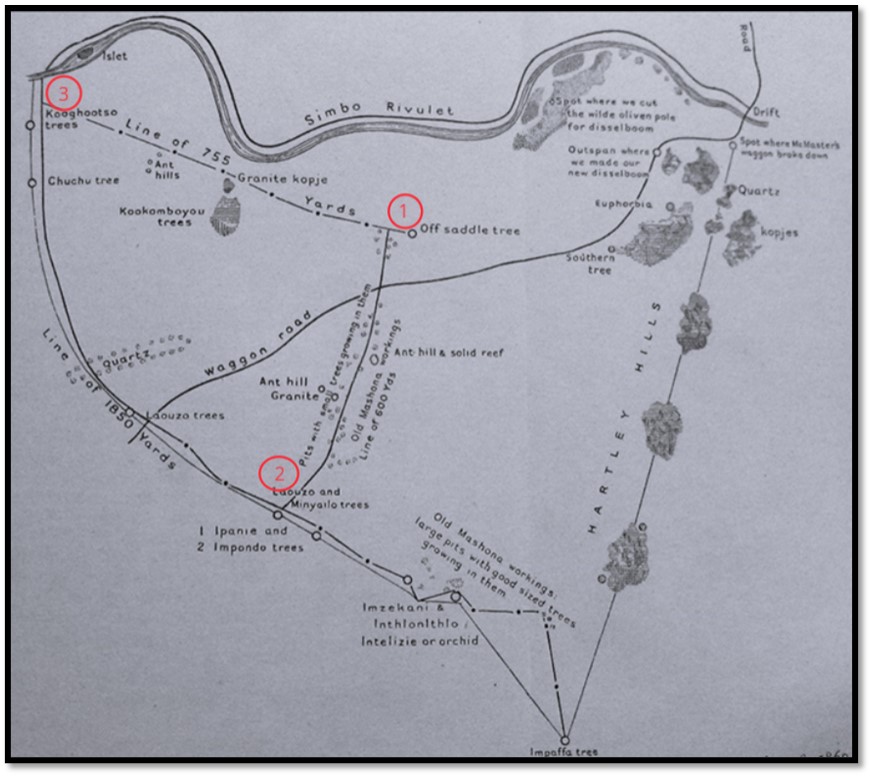
Claim diagram drawn by Thomas Baines on behalf of the South African Gold Fields Exploration Company
In late June construction of a two-room house made of poles and dhaka and ant-hill sand begins. “After bath and [Sunday] morning service walk round to the south of the hill and fixed upon a small secondary plateau at its base as the site for our house. Decided on having two rooms 14 foot square with a passage of 6 feet between into which the front door will open, while inside it are the doors of the two rooms.”
The fever year of 1870
On 5 July Thomas Maloney and Thomas Leask rode into Hartley Hills from their camp on the Chirundazi, they had sad news. George Wood’s wife, their child, and her mother Mrs Fraser had died at their camp.[ix] Paul Jebe[x] had died near Umtigesa’s village near Wedza (Hwedza Mountains) The Hartley party had been in the Manesi Range and then went hunting at the Hunyani (Manyame) river, despite being warned against it, where Willie Hartley and O’Donnell caught fever and whilst trekking to higher ground along the Chirundazi both died along with the wagon-driver Toris (Pretorius) Henry McGillewie hunting with the Jennings party had died at the Serui river on 9 June.[xi] That year the unseasonably wet weather caused fever throughout the country – almost all caught malaria and there were many fatalities before the winter months brought relief.
Thomas Leask wrote: “all the rest of us pushed on after him [George Wood] like a lot of fools. This year has given us all a lesson which will not soon be forgotten.”
When Baines visited the camp next day he found Maloney and Gifford away hunting for meat, McMaster and Leask hunting elephant and George and Swithin Wood were in camp: “Some of the waggons were absolutely tenantless and amongst those that were occupied it was sad to behold the sunken cheeks, the hollow eyes and pale and haggard faces of men whom I had parted with so recently in the full pride of health and active strength…”
A journey to get supplies and pack-oxen from Mashona Chief Umtigesa
The survivors at the hunters camp on the Chirundazi were still convalescing as most were still weak from fever. As there was nothing more that he could do for them Baines took Inyassi and Golube on a hunting trip down the Mupfure past its confluence with the Serui, but little came of it. He borrowed Willie Hartley’s wagon from Thomas Maloney and with one of his own left on 15 July with Jewell for Umtigesa’s village on the Sabi (Save) river to the southeast leaving Watson in charge of the camp and instructions to continue with the house building. George Wood’s party with Leask, Maloney, McMaster and Gifford moved to Hartley Hills and outspanned under Constitution Hill – so named because Leask recommended that those recovering from fever climb it every day!
Baines and Jewell followed George Wood’s wagon tracks over the headstreams of the Umsweswe, Ngezi and the Umniati and reached Umtigesa’s on 19 July. A market was held for two days with sheep, goats and pack oxen were purchased with brass wire except for the pack oxen that were purchased for a musket each - this was to cause Lobengula’s annoyance later. The Mashona were well-skilled in making iron tools and mbira’s using ore from Wedza Mountain and Baines watched the smiths smelting and hammering at their furnace. When asked about gold, they said they did not pan or mine for it.
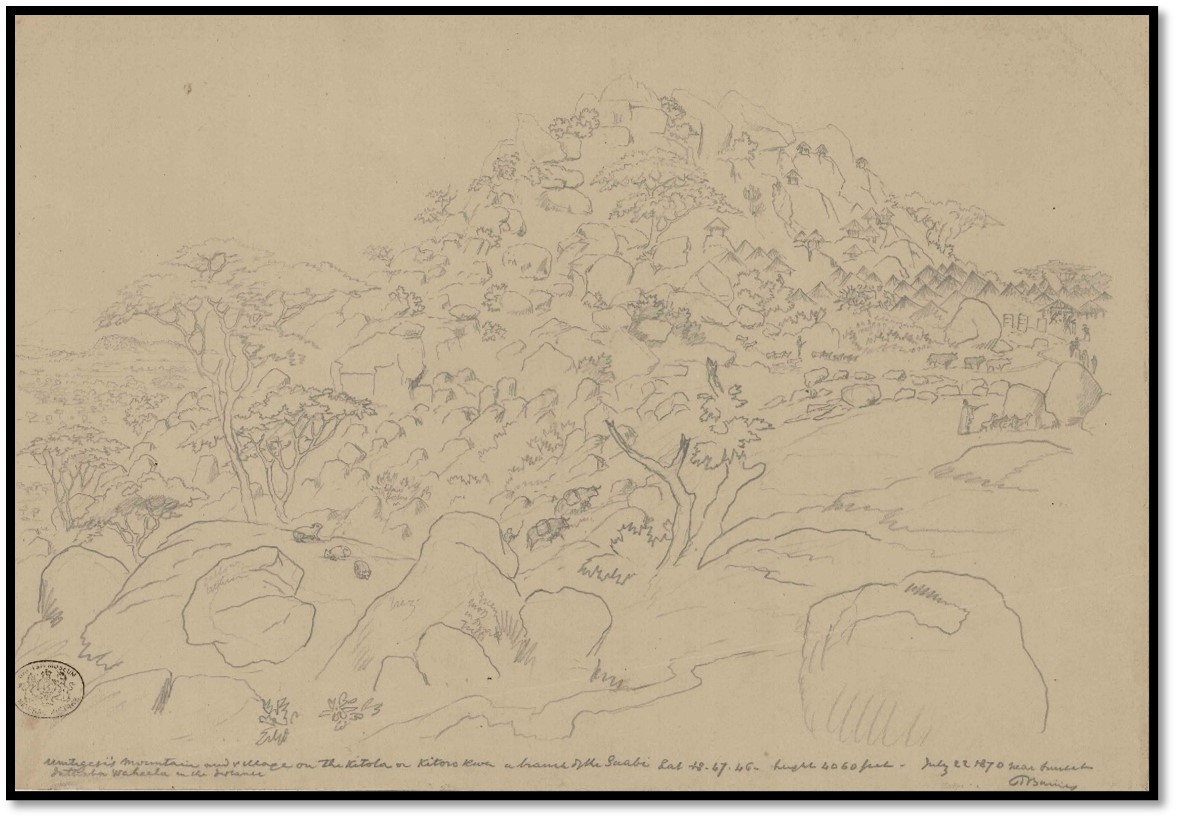
NHM (London) Baines Collection No 41: Umtigesa’s village (on right) on the Kitoro river, a tributary of the Sabi (Save) river sketched 22 July 1870
On the 25 July they started to retrace their path to the watershed; one of the pack oxen – a black ox, was so wild it was shot for meat, another was ambushed by a lion at the Umsweswe but recovered with treatment. “As Mackenzie came up and Jewell followed driving the leading waggon, my faithful henchman [Inyassi] also found courage to approach and I learned that a great man lion having been concealed in the long yellow grass, had suddenly sprung on the pack ox, but he, being the most powerful of the herd, had jerked himself clear and actually trampled on the lion in escaping.” Hartley Hills was reached on 30 July.
Another exploratory journey down the Mupfure river
Work on the house had slowed under Watson’s supervision. The drivers and amaNdebele attendants began to argue and say they wished to return to Matabeleland. After much debate with them Baines persuaded Jewell, Inyassi, Mackenzie and Golube with four of the pack-oxen bought at Umtigesa’s to go down the Mupfure river to do some prospecting and hunting. They travelled down as far as the Biri river confluence to the northwest of present-day Chegutu before returning. It was the season for grass fires, the air was thick with smoke, their kills comprising two waterbuck, a warthog and possibly a hippo, that they did not recover. Henry Byles came into Hartley Hills after hunting in the headstreams of the Biri, Serui and Chimbo streams and said he had been offered gold on the Ganyana (Hunyani / Manyame) river
“The result of the present little trip in this respect is that we have come upon old workings and quartz reefs which look as promising as those at Hartley Hills, in at least half a dozen different places.”
Henry Hartley visits his youngest son’s grave
Henry Hartley arrived at the Mupfure river on 20 August 1870 to see the grave of his son Willie Hartley who had died of fever on 29 May 1870.
Hartley brought news of Lobengula’s fight with the Zwangendaba regiment and the mining accident at the Halfway Reef. Baines hoped he would be accompanied by Nelson and workmen to commence mining operations, but this did not happen. He did however bring supplies of meal and coffee and two salted horses for which he accepted bills of £45 each on Behrens, the company’s Durban agent “and, as a proviso against any objection, shall also give a bill on my own pay”[xii]
“After this, Mr Hartley walked down with me to the north-east, or nearest corner of our ground, nearly the ‘off saddle tree’ as directed by Mr Nelson, and broke off several pieces of quartz, in some of which we found small specks of gold, though I have no doubt Mr Nelson would have picked out more in 10 minutes than we did in the whole afternoon. In fact, I've seen him do it on the very spot.”
Baines, Hartley, Jewell, Leask and Maloney set off on the 26 August to visit Willie Hartley’s grave but first came across the tracks of eleven elephant bulls in a bachelor herd. Five were killed with Baines losing his hat and gun during the chase, although they were subsequently found. Jewell was bucked off his horse. The hunters rode west to Mud Spruit on the Hunter’s Road for the night and next day visited Willie Hartley’s grave; Jewell taking a photograph and Baines making the sketch below.[xiii]
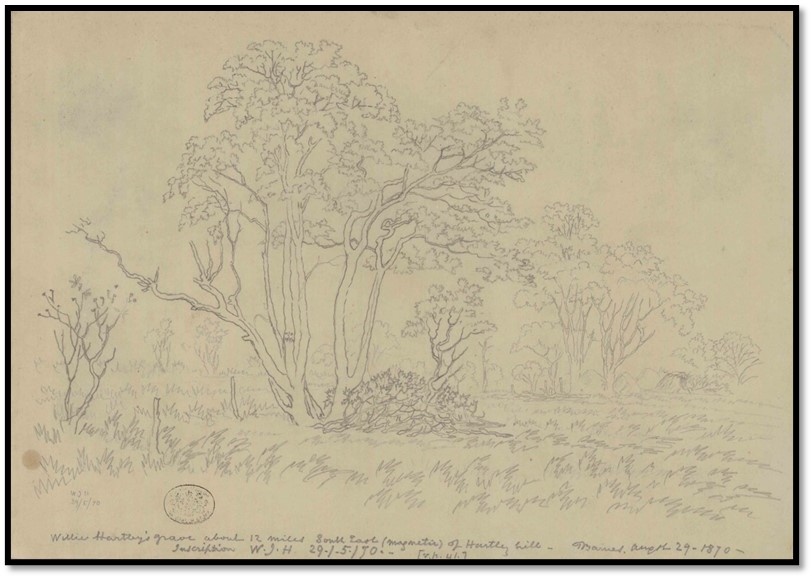
NHM (London) Baines Collection No 45: Willie Hartley’s grave east of the Chirundazi stream who died of fever on 29 May 1870
amaNdebele unrest at camp
“At daybreak, we rose and prepared for the intended trip. When the three men whom I told to accompany me refused, on the plea that they had not come to hunt elephants but to dig for gold, I told them they come to work without making agreement as to the kind of employment. I told Watson to speak to Inyassi and to explain to him that I was not going to hunt elephants, but to see the country which the king had given me leave to see.” Golube led most of the complaints and appeared to be the ringleader; finally Baines’ patience snapped and he thrashed the young man who was allowed to stay in camp as long as he was out of Baines sight.
“Soon after crossing the Simbo (Chimbo) river we passed a reef which I had seen last year and turning north-east past Constitution Hill, Mr Hartley showed me the reef where a 60 lb specimen which was said to have been carried 60 miles was picked up. It appears that Mr Hartley's waggon was standing at the Sarui (Serui) river, a little more than 4 miles north. Hartley and the hunters were after elephants and one bull led right over the reef through the old mines and across the Chimbo rivulet above the hills where are house is and was killed. On his return, Mr Hartley informed Mr Mauch and about 12 days after, when the waggons were passing, Mr Gifford pointed out the spot to Mauch.”
George and Swithin Wood invite Baines to their camp to inspect gold workings
The Wood brothers said they had seen Mashona gold diggings still being used near their camp.[xiv] George Wood had bought a third of a quill of gold from a Mashona. He asked where it came from and the answer was: “Is it not everywhere?”
Baines rode with them to the Biri river where they examined ‘the Portuguese house’ with a dry-stone wall enclosing a space of 15 x 18 metres[xv] This is clearly not Maramuca - no mention is made of crossing to the west of the Mupfure river and there is no mention of sun-dried bricks – a feature of Portuguese feiras, although local Mashona believed it had been a Portuguese trading post.
Their camp was north-east of present-day Chinhoyi and here they showed Baines quartz reefs and old workings. George Wood asked the local Mashona to show them how the gold was extracted, but they all denied any knowledge of gold-working although we know that Chief Lomagundi (Makonde) was mining gold at the Eldorado mine, east of Chinhoyi, in the 1870’s.
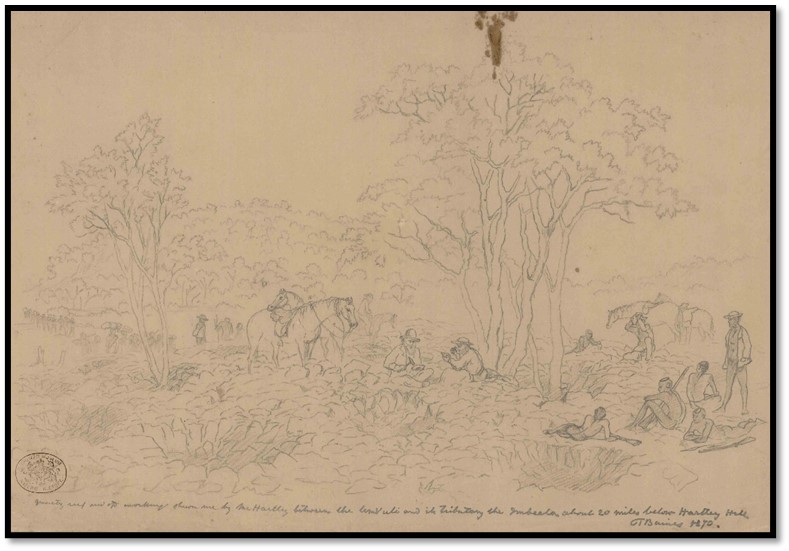
NHM (London) Baines Collection No 44: Baines and Hartley examining quartz at Mashona diggings at the Imbeela river 30 km below Hartley Hills – 6 Sept 1870
The hunters begin to leave Mashonaland at the end of the 1870 winter season
Henry Byles left on 19 August, Leask, McMaster and James Gifford on 1 September, Hartley and his son-in-law Maloney on 17 September, George and Swithin Wood on 22 September.
Baines packed up his quartz samples, still disappointed that Nelson had not returned and leaving Jewell to finish packing the wagons and follow on, left Hartley Hills on 26 September hoping to catch up with Hartley’s wagons. True to form the Oude Baas had stopped to hunt, although he lost his shooting horse Camelback, to tsetse-fly.
On 1 October they were joined by George and Swithin Wood at the Umniati (Munyati) river forming a convoy of eight ox-wagons. Two days later they came across an elephant herd of over a hundred and killed eight, their attendants brought the tusks to the Sebakwe river on the 5 October.
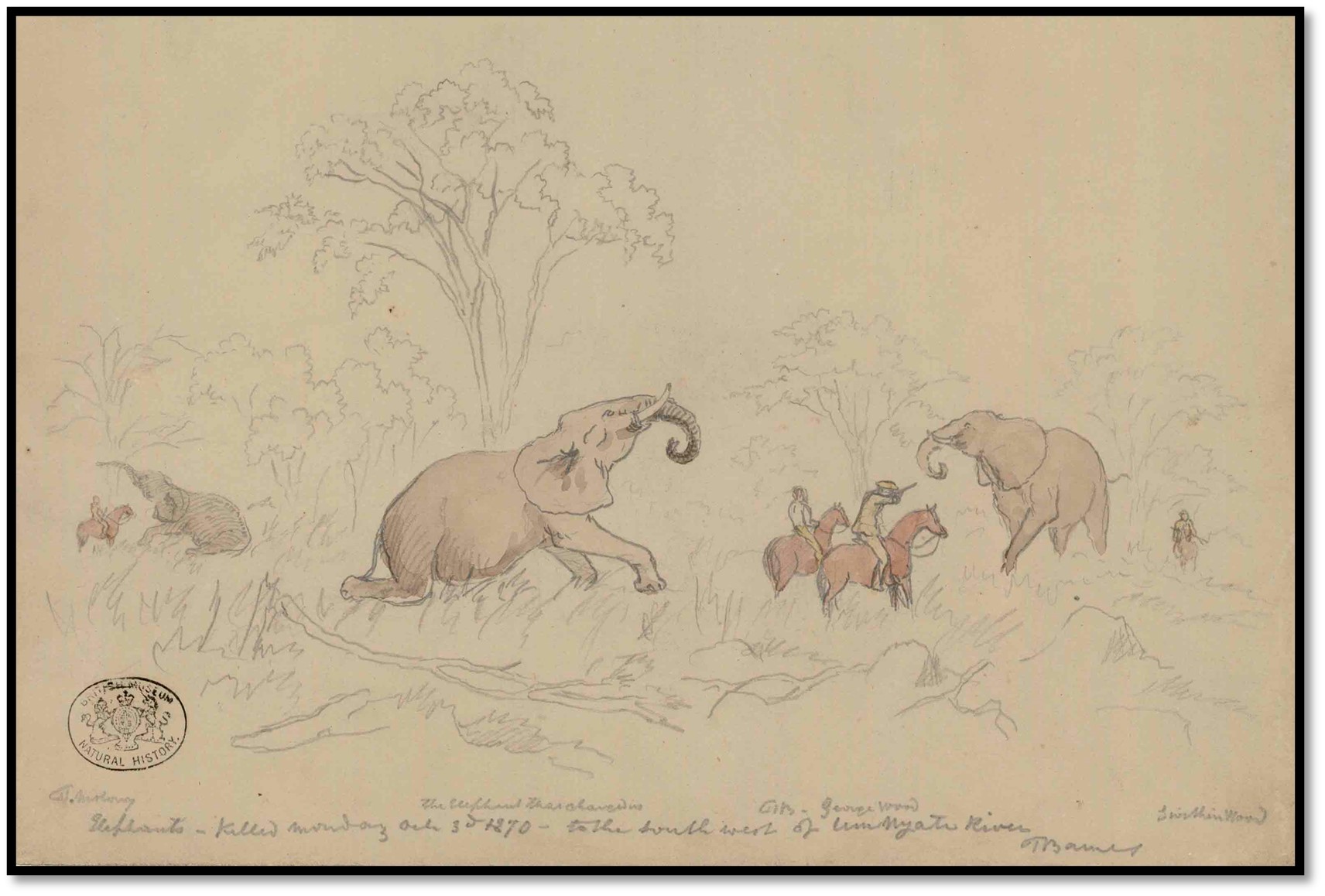
NHM (London) Baines Collection No 105: Elephant hunt on 3 October 1870, southwest of the Munyati river
Thomas Maloney George Wood Swithin Wood
Baines plans a visit to the goldfield that Mauch visited in August 1868
Two years previously Karl Mauch had written: “The vast extent and beauty of these goldfields are such that, at a particular point, I stood as if transfixed, riveted to the place, struck with amazement and wonder at the sight, and for a few minutes was unable to use the hammer.”
Mauch’s account is worth quoting from his journal: “From Umniati (Munyati) it takes 8 hours to the Sepakwe (Sebakwe) and another two hours to the Pembesi (Bembezaan) As the waggon had left, the Umzweswe (Umsweswe) the hunters searched for elephants in the mountains situated to the east, but they returned unsuccessfully and were consequently tired of any further hunting. Without a break we resumed the usual method of travelling by ox-wagon.
Near a small tributary of the Umniati (Munyati) I left the party, together with my erstwhile companion [Makhombo] to undertake a third tour on foot to the ‘diggings’ in the west and to return again along the Pembesi (Bembezaan) I decided to do this in two days. The 25 August was hot and windless and rough gneissic rock, burnt stalks of ten feet high, dry, stiff and pencil thick grass, sparse, shade less tree growth and lack of water soon tired me and it was late in the afternoon when we reached the junction of the Pembesi (Bembezaan) and the Sepakwe (Sebakwe) To the north of the latter we wandered in the goldfield over quartz and schist and so it continued until we were forced at the setting of the sun to spend the night amongst the most beautiful geological formations. Makombo wanted to guide me further westward between the Sechwechwe and Sepakwe on the following morning, but I would not contemplate this. ‘If gold is to be found anywhere, I told myself, then it must be right here’....taking only a few easily collected quartz samples with me, I refuse to follow old Makombo to a place that, far away, was supposed to be rich in darama (gold)…”[xvi]
Baines account of the visit to the ‘Bembesi’ gold fields
On 6 October Baines set off with the same Makombo that guided Mauch, Inyassi and five others. After crossing the Sebakwe they had an encounter with a black rhinoceros that was first shot by Baines and then stabbed with assegais by the warriors. Next day they travelled to the northwest: “til we came to the Mangoma where we found the diggings he had shown[xvii] [Mauch] The principal pit was perhaps 25 feet long, 15 feet wide and 10 or 12 deep.[xviii] Out of the northern side of it grew a maghondie tree and out of the east a smaller kind with drooping leaves, called a gangania. Here, I was told, Mauch broke the stones and here it was that his mind seemed first to realise the vastness of that discovery which, long after the disputes it has given rise to are forgotten, will transmit his name to future ages as the scientific, in connexion with that of Hartley, as the practical discoverer of the gold regions.[xix] I also broke several pieces of quartz and examined them carefully with the microscope, testing any little specks with nitric acid, but I cannot say that I found gold. I wish I had, for the satisfaction of our company, but for myself I think but little of this…
…Passing on to the northwest across a little gulley, we came upon a solid reef extending nearly north and south for about half a mile and I broke and examined several pieces of quartz, also without success. At 11am we struck north west to the Bembesi (Bembezana) and made breakfast…
…We returned to a set of diggings nearer to the river and worked for an hour getting any quantity of iron pyrites and other metals, but not gold. The trees in these holes are 10 inches or a foot in thickness. The boys helped me look for specks, but they are not sorry to find nothing, as they have the less to carry. About 3pm we crossed the Bembesi (Bembezaan) just deep enough to give us a pleasant foot bath as the narrow stream ran over a portion of its broad sandy bed.”
Returning to the wagons at the Hunter’s Road, Baines shot a bull buffalo.
Onward journey to Inyati mission
Once they reached the wagons Inyassi’s thinly veiled defiance turned to unruliness and he hotly questioned Baines right to prospect, despite Lobengula giving Baines the authority to do so between the Gweru and Manyame rivers and he told the others not to accompany Baines: “telling me that the king had not told him I was to go and look at these holes and that he would not let the people go.” When the row turned to a spat, Inyassi seized an assegai that Baines knocked from his hands before he picked up Watson’s breech-loader and ran off. Next day Inyassi returned asking for forgiveness that was granted.
On 18 October Hartley emptied a wagon and accompanied by Baines and Jewell took a southeast track for about 34 km and in the afternoon they began to see native gardens with maize granaries on isolated granite boulders and finally a village of pole and dhaka huts set into a kopje. The headman was Tabooka and his village along with three or four others were under Inyoka, Hartley’s amaNdebele guide. Maize, as well as millet, rice, sheep and goats and beer were bartered.
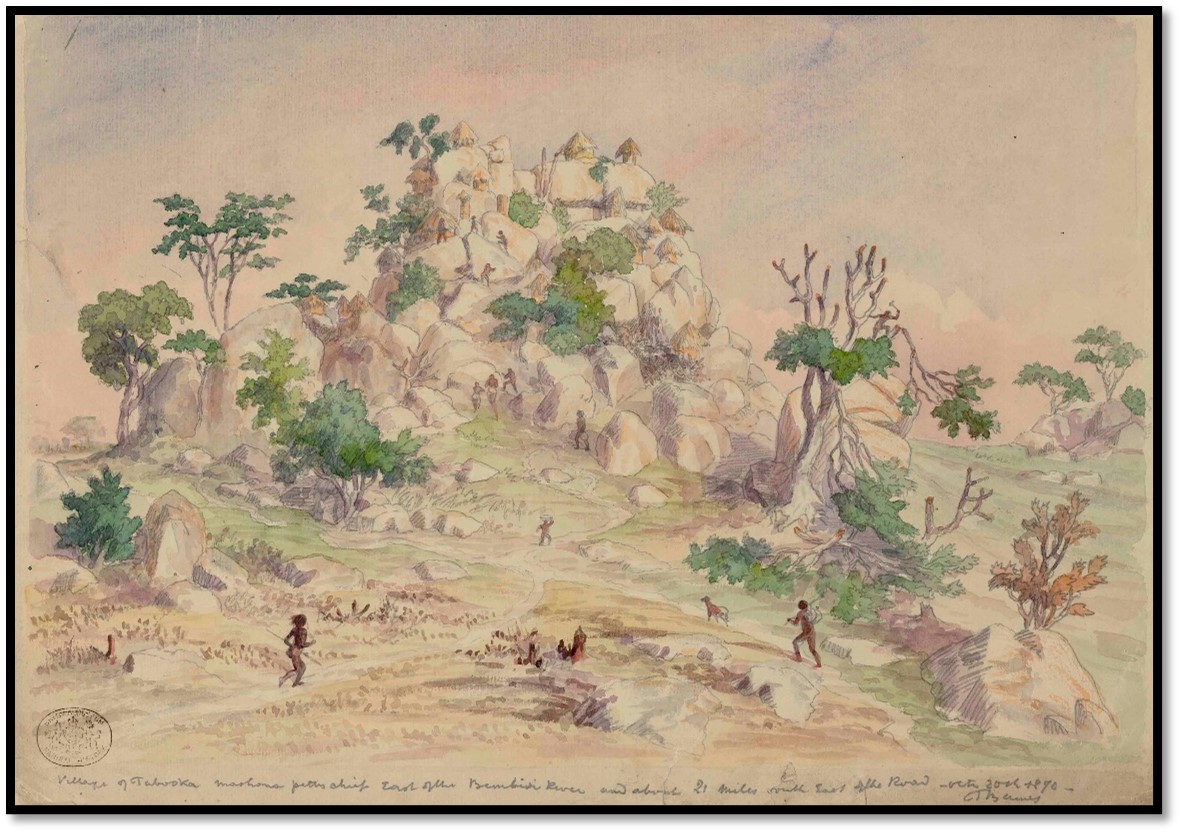
NHM (London) Baines Collection No 56: Tabooka’s village, a Mashona petty chief about 34 km southeast of the Bembezaan stream where provisions were obtained from the productive native gardens
From the 22 October all the wagons moved quickly west – the amaNdebele eager to get home and Baines and Jewell reached Inyati mission on 28 October; Hartley, McMaster and Maloney only arriving on the 3 November after a last, unsuccessful, elephant hunt.
Respite at Inyati mission
Baines enjoyed the change from the hardship of trekking. Revds. Sykes and Thomson welcomed him into their families, the Thomson’s had a new son, fresh bread was on the table following the Thomson’s good crop of winter wheat and McMaster’s daughter Euphemia was christened.
In the mail was a letter from Behrens, the Durban agent, saying no money had been received from the company to pay the drafts Baines had issued on Durban. A letter from Nelson said he was going to London to persuade the directors of the need for further funding. Baines wrote to Lee at Mangwe asking him to help to get a written mineral concession signed by Lobengula and Hartley agreed to help.
Trek to koBulawayo
Lobengula’s capital was reached on 11 October. On the way Baines learnt his mother had passed away and Oliver, the London company secretary, wrote to say the London directors approved of his arrangements and would try to find further funding, Nelson was in England but had not yet approached the directors.
Many of the ‘old-timers’ were at koBulawayo at this time along with newcomers. Thomas Baines, Carter, Finlayson, William Francis, George Gordon, Harry Grant, Henry Hartley, Daniel Kisch, John Lee, Thomas Maloney, Henry Ogden, George Phillips, Robertson, John Spearman, Mr and Mrs John B. Thomson, Richard Watson and others.
The king grants land to the London Missionary Society for Hope Fountain
Thomson wanted a mission nearer the new capital and had selected land at Hope Fountain. He asked the king on 14 November and was supported by Baines and Lee with Watson interpreting. However unlike Inyati where the land was granted by Mzilikazi directly to Robert Moffat, Thomson asked on behalf of the London Missionary Society. The king was reluctant – remembering the Tati district controversy with Levert of the London and Limpopo Mining Company – but finally relented and agreed on the 21 November. No trading was to be allowed at Hope Fountain mission.
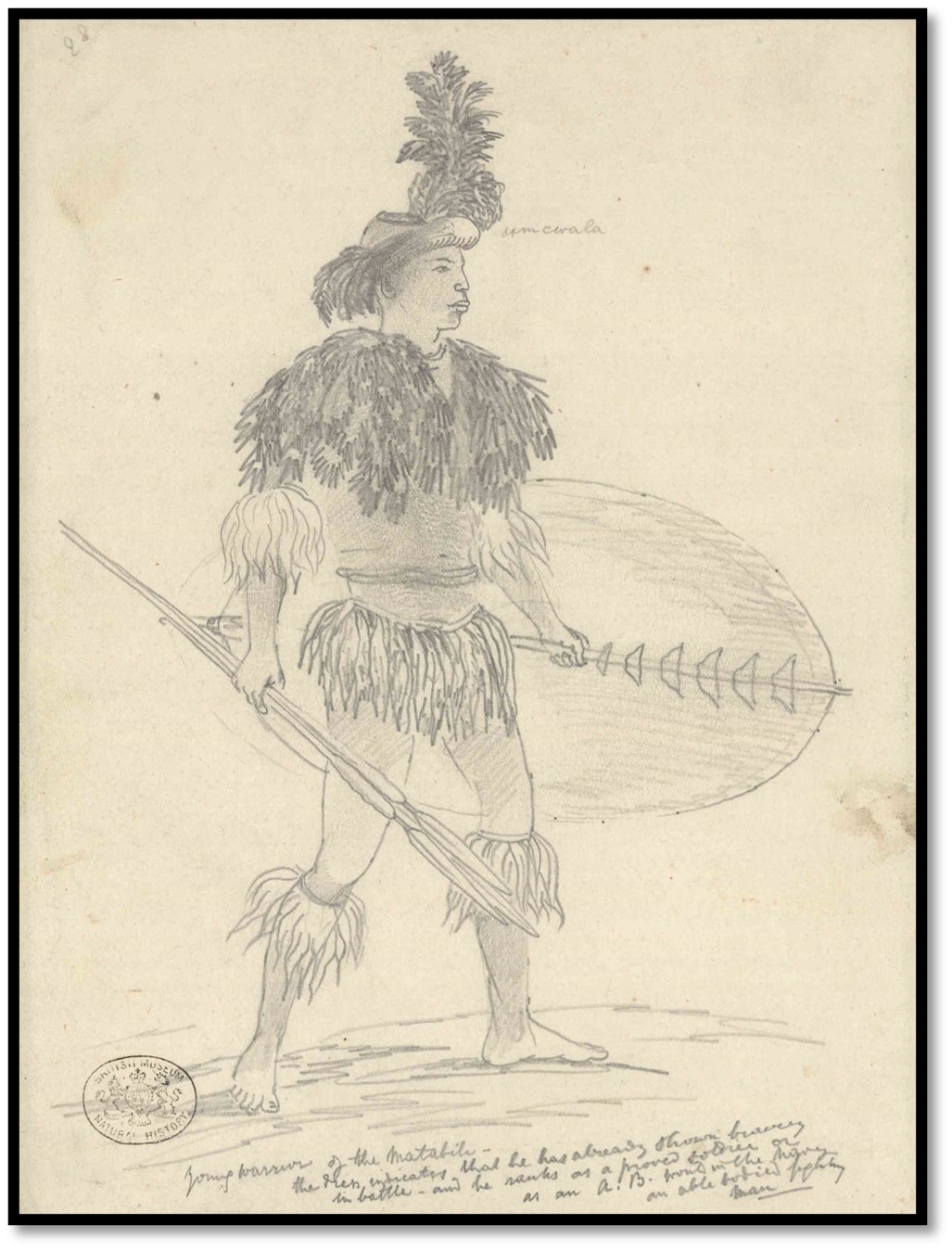
NHM (London) Baines Collection No 77: a young Majaka (amaNdebele warrior-soldier)
The Transvaal Republic wished for a peace treaty with Lobengula
The Transvaal hoped for a treaty to regulate the entry of Europeans into Matabeleland as they feared it was being flooded by gold seekers who would eventually persuade the Foreign Office to annex Matabeleland. The king was not negative to the concept but was offended that Henry Hartley was the Transvaal’s representative and they had not sent an appointed ambassador. He also thought John Lee could not serve the Transvaal and be his agent at Mangwe at the same time. Eventually nothing came of it although there was tension between Lee and Hartley at the time.
An amaNdebele regiment returns from a raid on Mashonaland
On the 15 November; “About 9 we saw the advanced guard coming over the distant hills and all the morning fresh parties and herds of oxen kept arriving at the halting place outside the town.” They formed up in a line two deep around the king. “They numbered about 1,200 – 1,400 men and with their large oval shields, some black, some black and white and others red and white according to the colours of their regiments and their large capes of black ostrich feathers and head wreaths and tall plumes of the same, they looked as formidable a body as one could wish to meet.”
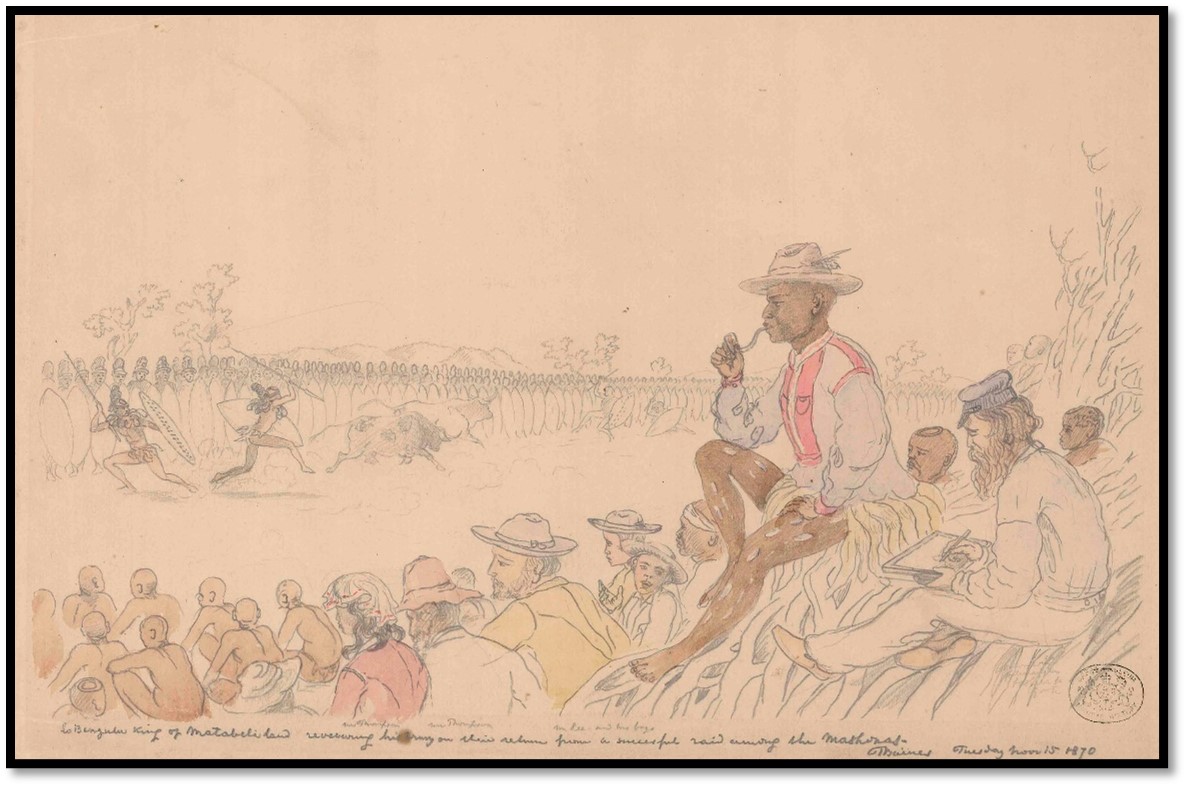
NHM (London) Baines Collection No 60: Lobengula reviewing his army after a successful raid on Mashonaland, Revd Thomson and his wife with John Lee and his sons in front, Baines portrays himself as the artist
Will the South African Gold Fields Exploration Company get a written mineral concession from Lobengula?
Baines and Lee believed that the time might not be right – the king may believe he was being tricked into giving away part of his country in Mashonaland and cancel their verbal grant of 9 April. However on 23 November the matter of a mineral concession for the company was again discussed with the king; Baines, Lee, Hartley and Thomson being present. Lobengula reprimanded Baines for bartering guns for pack-oxen with Umtigesa but then let the matter drop. Baines reported the gold found at Hartley Hills and explained how it was extracted from the quartz. Lobengula once again confirmed the grant of the mineral concession for an annual £100 gift. Clearly the king was still worried about Levert’s actions and emphasised the concession did not include any land being given up. He also denied that the Tati concession gave Levert any right to grant mining licences to others – they all had to come from him.
At the end of November an Australian party that came to koBulawayo to challenge Levert’s authority were given a concession by Lobengula with two amaNdebele being sent back to Tati to witness the claims.
Baines receives a letter from the Portuguese disputing that the company’s concession was valid
Baines received a letter from the Portuguese governor of Quelimane, Carlos Barahona, stating Matabeleland and Mashonaland were Portuguese possessions falling under the district of Sofala and any treaties made with local chiefs were not valid without Portuguese approval.
He replied saying the Portuguese claims dated from the 16th century and the Mutapa (Mwenemutapa, Monomotapa) State, but that the Portuguese no longer had effective occupation; that the amaNdebele did and that the Portuguese rights had been invalidated by later conquest.
Baines says farewell to the king and leaves for Mangwe
Baines needed to go to Tati to hear what plans the directors of the South African Gold Fields Exploration Company had for the future. If there was no news at Tati he would travel onto Natal to find a suitable gift for the next year and hire a new miner if Nelson was not returning. Lee, Hartley, Baines, Jewell and Watson left the king’s capital on 25 November; the king visited as they inspanned and bid them farewell.
At Mangwe Baines gave Lee bills drawn on Reid, their agent at Potchefstroom and hoped the company would honour them. Sara Lee was about to wed David Jacobs and Baines sketched their wedding portrait and wrote on Lee’s behalf to Revd Thomson asking him to marry the couple.
Arrival at Tati
Levert was away in Natal, still unwell after the explosion, but Acutt the company secretary of the London and Limpopo Mining Company was hospitable and exchanged trek oxen. He had also received the same letter from the governor of Quelimane and showed Baines 27 oz of gold but said the gold recoveries were poor because the battery was old and not crushing efficiently and most of the miners had left for the diamond fields. The cost of transport from Natal was prohibitively expensive as everything had to be brought up except food that was available from the Makalanga villages but had to be bartered for. The London and Limpopo Mining Company was prepared to crush the smallworkers ore on tribute, but most had found the mining unprofitable, abandoned their claims and drifted away.
Bunting Lodge, built by Edward Coward, was burnt down as was ’Captain’ Richard Burrill’s house, most of the others were empty and falling down. Besides Acutt who was in charge of operations with Levert away, Dr Coverley was about to leave for Scotland; Griete, Arkle, McDonald, Ogden, Franklin and Brown were resident with three men at the Bluejacket mine and nine at Todd’s Creek.
Baines leaves for Natal
Baines left Tati with Maloney and Dr Coverley on 6 December; Hartley had gone on a hunting trip on the Shashe river. Hartley with the three Jennings brothers caught up with the Baines party at the Mhalapshwe river on 18 December where they met two wagons of the London and Limpopo Mining Company at the drift that were carrying supplies and mail to Tati. However the attendant would not release Baines’ mail in his master’s absence. He and Klaas, Hartley’s gunbearer, rode into Shoshong, but missed Bullen and Baines went back to the wagons and found Bullen at the Towani river.
In a letter Oliver wrote from London that the quartz samples had assayed from 3 – 60 oz / ton and acknowledged Lee’s contract. Baines and Klaas caught up with the wagons, but the Marico river was in flood and a whole day was spent in fording it with the wagons. The trek continued without further delays and Hartley’s Thorndale Farm in the Magaliesberg was reached on 29 December.
References
F.O. Bernhard. Karl Mauch, African Explorer. C. Struik (Pty) Ltd, Cape Town 1971
Hall R.N. and Neal W.G. The Ancient Ruins of Rhodesia. Methuen, London, 1902
R. Summers. Ancient Mining in Rhodesia. Trustees of the National Museums of Rhodesia, 1969
E.C. Tabler. The Far Interior. A.A. Balkema. Cape Town, 1955
E.C. Tabler. Pioneers of Rhodesia. C. Struik (Pty) Ltd Cape Town, 1966
J.P.R. Wallis (Editor) The Northern Goldfield Diaries of Thomas Baines Volumes 1 – 3. Chatto and Windus, London 1946
Notes
[i] Northern Goldfields Diaries - Introduction
[ii] ‘Captain’ Richard Burrill led the Gang of Hope party of 9 prospectors including Richard and Thomas Burrill. They had all worked on the construction of the Umgeni Railway in Natal and reached Tati on 23 January 1869. Richard Burrill tried to raise funds in Natal for crushing plant but without success and his house at Tati was burnt down by the end of 1870
[iii] Major David Erskine was Colonial Secretary to the Natal Government and knew Baines well
[iv] R. Hudson died of fever at Hope Fountain mission on 19 May 1870
[v] At this time Baines does not know that Nelson will no longer be working for the South African Gold Fields Exploration Company
[vi] A salted horse was one that had gained a natural immunity or recovered from horse-sickness. They were worth five to ten times as much as those that had never had the disease. Tabler quotes (P84) quotes an average price of £75 between 1857 – 1890 although the price clearly depended on age, quality, training and availability. They were much prized by hunters in the interior – guarantees were often given with from 60% - 100% of the purchase price if it died with 1 – 2 years after purchase.
[vii] Arthur Levert left the Tati district for Natal in June 1871 because of his poor health and died in England in 1873 / 1874
[viii] Northern Goldfields Diaries P451
[ix] No mention is made of their graves and they do not appear to have visited them
[x] Paul Jebe was Karl Mauch’s travelling companion. See a photo of him in the article Karl Mauch, explorer and geologist and the man who claimed to be the first European to visit Great Zimbabwe under Masvingo province on the website www.zimfieldguide.com
[xi] The Serui also called the Salagozaan because a little old woman was killed there by the amaNdebele, also called Mopanie river and by Karl Mauch Sterkstroom.
[xii] This is typical Baines; the goods are for company use, but he is prepared to pay personally
[xiii] Northern Goldfields Diaries P457; from the hunters camp 10 on the Chirundazi miles southeast of Hartley Hills: “Then turning east we crossed the river and riding about an hour and a half more, we reached the spot where poor Willie Hartley’s grave had been made three months before.”
[xiv] The Wood brothers camp was 80 km northwest of Hartley Hills, a few miles north and east of present-day Chinhoyi and chief Lomagundi (Makonde)
[xv] The Lower Umfuli gold belt is to the west of the Mupfure river with the Portuguese settlement of Maramuca near the Suri Suri river and many goldmines around Chakari including the Dalny and Bay Horse Mines.
[xvi] Karl Mauch P70
[xvii] The word has slipped off the diary, but presumably is ‘Mauch’
[xviii] I can find no trace of gold mines between the Sebakwe and Bembezaan rivers and conclude that although Baines writes that they crossed the Bembezaan after seeing the diggings, he had been at the site of the future Gaika mine that is 12 km west of the Bembezaan river. H.E. Jones in 1903 described the Gaika Mine as: “I believe the most extensive series of ancient workings in Rhodesia” and from his plan there about 160 separate stopes in 25 acres. Summers P94
[xix] Here Baines credits Hartley for discovering the goldfield, but although Hartley suspected the diggings were for gold, he had no way of proving it. Karl Mauch, in his usual fashion, attributes the discovery to himself.
When to visit:
n/a
Fee:
n/a
Category:
Province:
